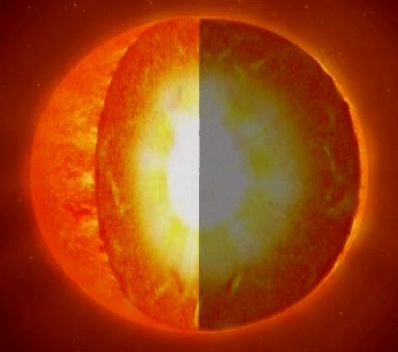BY DR EMILY BALDWIN
ASTRONOMY NOW
Posted: October 24, 2008
The CNES/ESA Earth orbiting COROT satellite has applied the technique of seismology to the study of stellar interiors, probing the interiors of three stars beyond our own Sun for the first time.

COROT can detect 'starquakes', acoustic waves generated deep within a star that ripple across the star's surface, altering its brightness. By studying these variations, a star's mass, age and structure can be determined. Image: CNES.
Like the propagation of seismic waves on Earth providing information about our planet's interior, sound waves travelling throughout the Sun and other stars carry information about what is happening below the surface. The study of these waves propagating through a star is known as helioseismology, and has already been used to generate complex models of the interior conditions on our Sun, showing that different layers of our home star rotate at different speeds to generate the Sun's magnetic field, and that jet streams of plasma run thousands of kilometres below the surface.Oscillations of the Sun's surface can also be tracked by direct observations and related to interior processes by the tool of helioseismology. Similar oscillations can be observed on other stars by watching for variations in the light emitted by the star as the surface wobbles, revealing both the internal structure of the star and the way energy is transported from the core to the surface.
"Other techniques to estimate stellar oscillations have been used from the ground, but they are limited in what they can do," says Malcolm Fridlund, ESA Project Scientist for COROT at ESA's European Space Research and Technology Centre (ESTEC). "Adverse weather conditions, plus the fact that you cannot observe stars during daytime, oblige ground astronomers to interrupt their observations."

COROT consists of a 27 centimetre telescope and was launched in December 2006. Image: CNES/D. Ducros.
The COROT satellite allows uninterrupted viewing from afar, and with high sensitivity instruments such as a 4-CCD camera capable of recording tiny variations of light intensity emitted from a star, COROT offers a new view of our stellar neighbourhood. In the new study, three Sun-like stars were scrutinized by COROT: HD499933, HD181420 and HD181906, revealing 'sunquakes' rumbling inside their interiors.
"The fact that COROT succeeded in probing the interior of Sun-like stars with direct measurements for the first time is a huge leap in understanding stars in general", says Fridlund. "In addition, this will help us to understand, by comparison, our own Sun even better."
COROT was launched at the end of 2006 and was designed as both a planet hunter and star surveyor, having clocked up six exoplanets to date with the aim of surveying around 120,000 stars for exoplanets, and over a hundred stars for stellar seismology studies.
"The fact that COROT succeeded in probing the interior of Sun-like stars with direct measurements for the first time is a huge leap in understanding stars in general", says Fridlund. "In addition, this will help us to understand, by comparison, our own Sun even better."
COROT was launched at the end of 2006 and was designed as both a planet hunter and star surveyor, having clocked up six exoplanets to date with the aim of surveying around 120,000 stars for exoplanets, and over a hundred stars for stellar seismology studies.
.
Lucimary Vargas
Presidente
Observatório Astronômico Monoceros
Além Paraíba-MG-Brasil
observatorio.monoceros@gmail.com

Nenhum comentário:
Postar um comentário